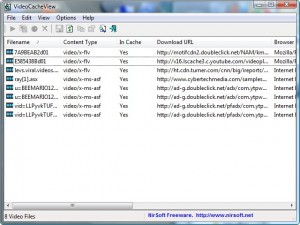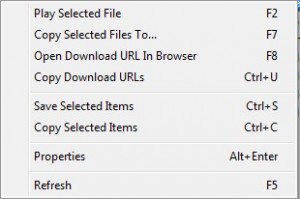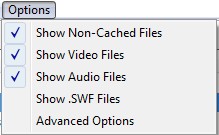URL Snooper is a pretty popular software for allowing you to download streaming videos/audio off the internet. However lately I have been having a problem with URL Snooper and YouTube videos. So I went looking for other tools and I came across two more masterpieces by Nirsoft.
VideoCacheView
You see whenever you watch a video on the internet, the video is downloaded into something known as your browser’s “cache”. VideoCacheView simply views your browser’s cache and tells you about the videos in there. Then all you have to do is right click it…
…and select “Copy Selected Files To…” to save the video else where on your computer. The advantage of using this grab-video-from-cache method is you do not have to re-download a video you just viewed – it is already existing in your cache. The problem with this method is the video names will not be properly generated (this is not the program’s fault) so you may have to guess a couple of times to find the correct video (just do “Play Selected File” before saving it to a permanent location on your computer).
A couple of things more to note:
- VideoCacheView works with more than videos:
- VideoCacheView supports Internet Explorer, Firefox, Opera, and Chrome:
WebVideoCap
WebVideoCap takes a different approach to downloading streaming videos off the Internet. Similar to how URL Snooper works, WebVideoCap monitors and sniffs your network traffic looking for Flash (FLV, MP4, and SWF) and WMV video traffic and RTSP/MMS streams. When it finds such traffic/stream it automatically saves the video onto your computer.
Since WebVideoCap monitors network traffic, it is browser independent. However I would like to point I am having trouble getting it to detect streams while using Firefox (I plan on doing more troubleshooting later). However it works just fine when I try when I use Internet Explorer. WebVideoCap now works just fine for me while using Firefox and Internet Explorer both. One thing to keep in mind with WebVideoCap is since it monitors your network traffic, it may take a minute or two for it to detect a streaming video so be patient; it will not be as fast as VideoCacheView.
Another thing to keep in mind is as files are downloaded with WebVideoCap, they will be automatically named with a naming scheme (see “Filename Prefix”). So be sure to rename them as you get them or else you may have a problem identifying which video is what if you download many of them at once.
Last thing to note about WebVideoCap is if you are using Vista SP1 and higher you will need to download the WinPCap driver.
To conclude this post, I highly suggest you download both these programs and keep them in your arsenal to help you download streaming videos/audio from the internet. Since they both take a different approach, between them you will hardly ever miss a video/audio you need. If you are worried about wasting hard drive space, don’t worry. I bet your math homework takes up more space on your hard drive: both of the portable versions of VideoCacheView and WebVideoCap are less than 100 KB each after you unzip them. However if you do plan on downloading and using both, just be sure you are not downloading the same file with both programs – that will waste hard drive space.
You can download both programs from the following links:
Click here to download VideoCacheView | Portable version here

 Email article
Email article








